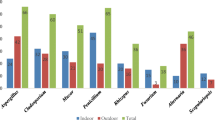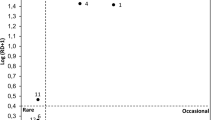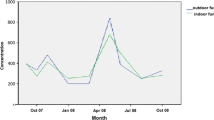Abstract
Penicillium species, well-known indoor airborne fungi, are considered to be important causative agents of extrinsic bronchial asthma. For selecting the proper species for clinical investigations, it is important to know which are found indoors. In the present study, 176 plates of modified Mehrlich's Medium were exposed for 20 min in living rooms and bedrooms of 88 homes in Taipei, Taiwan. A total of 5897 colonies of fungi were isolated, varying from one to 329 per house. Of the total, 910 colonies (15.4%) were identified asPenicillium spp. The three most frequently encountered species wereP. citrinum, P. crustosum andP. implicatum. Penicillium citrinum accounted for 40.5% (369 from 28 houses);P. implicatum, for 5.2% (47 from three houses); andP. crustosum, for 2.1% (19 from seven houses).Penicillium citrinum was judged to be the most prevalent airborne fungus in Taiwan. The allergenic significance of this mold is under further investigation.
Similar content being viewed by others
Literature Cited
Al-Doory Y, Domson JF, Best J (1982) Further studies of the airborne fungi and pollens of the Washington, D.C. metropolitan area. Ann Allerg 49:265–269
Dworin M (1966) A study of atmospheric mold spores in Tucson, Arizona. Ann Allerg 24:31–36
Han SH, Chuang YC, Hsiong YM, Chao HY, Chang LY (1981) A follow-up survey on airborne fungal spore counts in the Taipei area. Chin J Microbiol Immunol 14:213–221
Howard WA (1984) Incidence and clinical characteristics of mold allergy. In: Al-Doory Y, Domson JF (eds) Mould allergy. Philadelphia: Lea & Febiger, pp 147–156
Jones EA Jr., Gerson KL (1971) Comparison of environmentally cultured molds with positive skin tests to mold antigens. Ann Allerg 29:525–530
Karlsson-Borga A, Jonsson P, Rolfsen W (1989) Specific IgE antibodies to 16 widespread mold genera in patients with suspected mold allergy. Ann Allerg 63:521–526
Lopez M, Salvaggio J, Butcher B (1976) Allergenicity and immunogenicity of Basidiomycetes. J Allerg Clin Immunol 57:480–488
Lumpkins ED Sr, Corbit SL, Tiedeman GM (1973) Airborne fungi survey. 1. Culture plate survey of the home environment. Ann Allerg 31:361–370
Morrow MB, Meyer GH, Prince HE (1964) A summary of airborne mold surveys. Ann Allerg 22:575–587
Muilenberg M, Burge H, Sweet T, Solomon W (1990)Penicillium species in and out of doors in Topeka KS. Abstracts, J Allerg Clin Immunol 85:247
Oren J, Baker GE (1970) Molds in Manoa: a study of prevalent fungi in Hawaiian homes. Ann Allerg 28:472–481
Pitt JI (1979) The genusPenicillum and its teleomorphic statesEupenicillium andTalaromyces. London: Academic Press
Pitt JI (1988) A laboratory guide to commonPenicillium species, 2nd edn. Commonwealth Scientific and Industrial Research Organization, Division of Food Processing. P.O. Box 52, North Ryde, N.S.W. 2113, Australia
Prince HE, Morrow MB (1963) Etiologic factors in allergic diseases: molds. Ann Allerg 21:471–475
Shapiro RS, Eisenberg BC, Binder W (1965) Airborne fungi in Los Angeles, California. J Allerg 36:472–475
Solomon WR (1967) Aeroallergens III. Fungi. In: Sheldon JH, Lovell RG, Mathews KP (eds) A manual of clinical allergy. Philadelphia, London: W.B. Saunders Company, pp 398–436
Sorenson WG, Bulmer GS, Criep LH (1974) Airborne fungi from five sites in the continental United States and Puerto Rico. Ann Allerg 33:131–137
Author information
Authors and Affiliations
Rights and permissions
About this article
Cite this article
Wei, DL., Chen, JH., Jong, SC. et al. Indoor airbornePenicillium species in Taiwan. Current Microbiology 26, 137–140 (1993). https://doi.org/10.1007/BF01577367
Issue Date:
DOI: https://doi.org/10.1007/BF01577367




